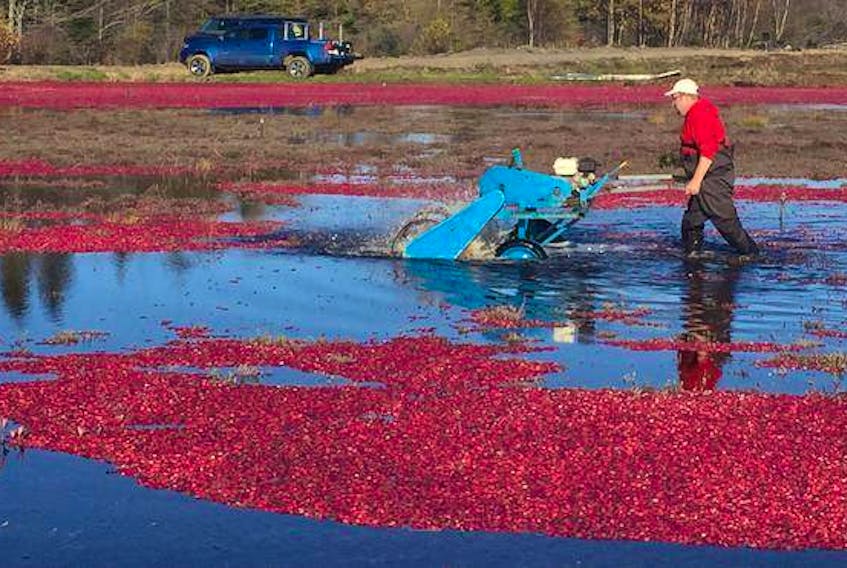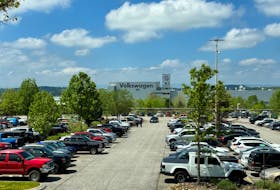Evelyn Ernst never tires of the sea of crimson red.
In fact, its beauty is unrivalled, she insists.
You might think Ernst would tire of the spectacle after the grind of 18 years running Terra Beata Farms with her husband David.
A bed of cranberries, thousands of them, stretch the entire length of the water-covered bog. On a sunny, crisp fall day such as the one on Tuesday afternoon in Heckmans Island, it is a sight to behold.
It is the product of hard work. Virtually all six Ernst family members can lay claim to the harvest’s bounty. As it turns out, it’s one of the best in the history of this 4.8-hectare family farm.
The shimmering swath represents success and devotion. You wouldn’t have found it a few years ago, after a bad case of cranberry fruitworm wiped out 75 per cent of their crop.
But for the last few days, practically from sunrise to sundown, the 180-kilogram cranberry beater has been chugging along. Like a lawnmower, it has created this display, churning up berries from carefully cultivated plants buried beneath the water’s surface.
Feeding the beast
“It’s like a beast and we all take our turn with it,” said Evelyn with a laugh. “But what you end up seeing is one of the most beautiful things in the world. The cranberries that are still attached to the plants are pulling up underneath and they float toward the surface. What you see is a gorgeous mixture of crimson berries and bright green leaves against the dark background. It’s something that never ceases to amaze me.”
Similar to last year, it’s shaping up to be a very good one. Nearly halfway through harvest, Terra Beata Farms has managed to load three tractor trailers full of cranberries. That will increase to seven by harvest’s end, likely by the second week of November.
Their processing plant, which employs 25 people, will continue to operate year-round, producing everything from frozen berries for local and international markets, to cranberry juice, sauces, salsa and chutney, to name a few.
They have come a long way in 18 years, considering that neither of them had any farming experience when they gambled on a less-than-glamorous piece of property opposite their house.

Going all in, getting knee-deep in work
David, an engineer, was employed in the fishing industry at the time. Seeing a downturn in the fishery, he decided to take the plunge. Still employed full time, he went to work clearing the land of brush and trees. For a good two years, he spent all of 45 minutes a day with family, recalls Evelyn.
Little by little, they made it work. Evelyn, a former teacher, agreed to go all in, too.
The kids followed suit. The youngest of the lot, nine-year-old Ella, has a critical role to play, being the designated tractor and excavator driver. She is also the trusted gas runner, ensuring none of the machinery goes dry.
“So the kids help with fertilizing, they help with setting up sprinkler heads, ditching and mowing dykes.
“But it gives the kids a sense of responsibility and a sense of self-confidence to have them do jobs where they can see that their efforts are making a contribution. I think it leads to raising physically and mentally strong kids.”
There are bigger cranberry farms around. Right now the Ernsts are content with their medium-sized one. They share a mutual pride of harnessing what little they were given, essentially a bog, and turning it into a thriving agricultural operation, and at the same time producing a hardy crop of berries native to Nova Scotia for thousands of years.
But it is a team effort. Their processing plant, for example, combines cranberries from roughly 10 different Maritime farms. It would not exist if not for those partnerships.
Then there’s the business of keeping on top of industry trends, ensuring their little island farm gets a fair slice of local and international markets. That means attending food shows in Germany and Paris, and consulting with the province’s department of agriculture on ways to alter soil fertilizer to produce solid yearly yields.
But beyond this, they agree there is something elemental about the way they choose to live their lives, even if it means just getting by at times. Even if it means leaving their safer lives behind.
“It’s a family thing,” said David. “Ultimately, you’re growing something together. We’re making something appear from the plants. It’s neat to eat food you’ve grown yourself and to share with other people.”









